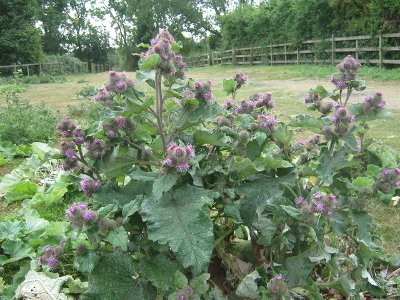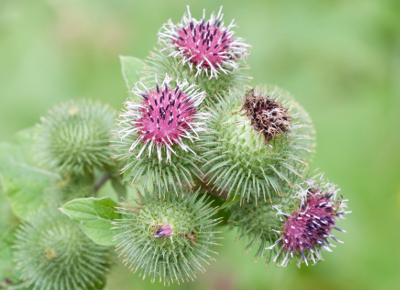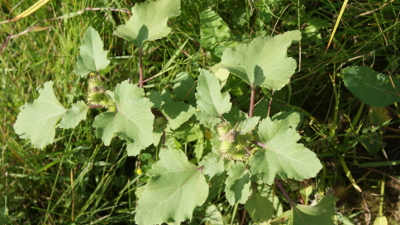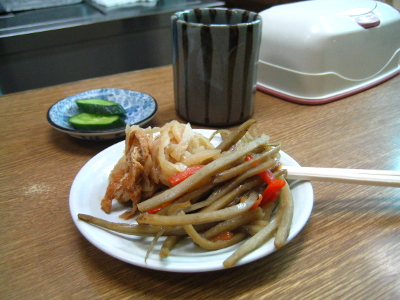Burdock

By Chris Byrd
Common burdock (Arctium minus) (also knows as burweed) is one of two species of plants in the genus Arctium native to Europe that have been introduced into North America; and have spread across the continent over the last three centuries. It holds many roles in the contemporary world of North America: invasive weed, permaculture plant, medicine, and food. Like so many plants that have found their way to new lands as human populations have expanded and relocated, burweed is seen as a boon, or a burden.
Identification
Common burdock is a biennial plant in the family Asteraceae.
Flowers: The flowering heads are composed of disc florets (no ray florets) sub-tended by 9-17 overlapping, adpressed rows of phyllaries that end in an inward pointing hooked tip that make up the involucre of the flower head. The disc florets are composed of a thin, bristly pappus subtending a light pink five petaled corolla, and a fused tube of purple anthers with white filaments and a bifurcated stigma emerging from the fused anther tube. The flowering heads are fairly tightly packed on short pedicels arising from the leaf axils.

Leaves: During the first year it sends out a basal rosette of large ovate leaves with cordate bases and acute tips. The margins are coarsely toothed and sinuate with a tiny projection extending off of each lobe. The leaves have relatively long hollow petioles. The petioles are hollow, grooved and lightly purple at the base (especially on the dorsal side). The base of the stalk is prominently furrowed dorsally. The leaf blades themselves are dark green dorsally and sparsely pubescent while the ventral leaf blades are lighter green with denser lanate hairs. The venation of the leaves is pinnate with obvious lateral and sub-lateral veins and a prominent mid-vein.

During the second year it sends up a flowering stalk with alternate cauline leaves that are smaller, but with a similar morphology to the first-year basal leaves.
Root System: Burweed is tap-rooted with lateral rootlets branching off from the main taproot.
Ecology of Burdock
Common burdock is a biennial forb (although sometimes the growth cycle can take 3-4 years when competition from other plants is significant) that grows best in fertile soils that have undergone an initial disturbance, but that do not undergo subsequent disturbance. It produces up to 15 thousand seeds per plant with a 90% viability rate. The seeds will last in the soil from 1-3 years. It prefers full sun or partial shade.
The hooked tips of the phyllaries that make up the involucre are an adaptation for seed dispersal. Animals that pass by a mature seed head often pick up and disperse the seeds as the hooked tips grasp onto the animal's fur, and later fall off spreading the seed to new locations.
Burweed often outcompetes smaller herbaceous plants in their vicinity by shading them out with their large leaves and spreading growth habit.
Agriculture/Permaculture Uses and Concerns
Common burdock is relatively easy to control due to its biennial nature. To control it simply till the soil before the flowering heads reach maturity to avoid spreading the seeds. The tilling destroys the taproot.
It can be an issue for people engaged in animal husbandry (especially sheep) as the hooks on the phyllaries tangle into the hair of sheep and devalue the wool.
Burweed has a several permaculture uses. One way to use in a permaculture system is to grow it as a mulch. The large leaves work well in a chop and drop mulching system. Another option is to grow dense patches as a hedge.
Be More Prepared For Your Next Outdoor Adventure!

Don't leave home without knowing these six essential survival skills. Our free survival mini guide reveals the strategies of:
- Shelter & fire to prevent the number one cause of death
- Obtaining clean water to avoid life-threatening dehydration
- Common wild survival foods and other critical skills!

Edibility
The tap root can be harvested and eaten during their first year of growth, with the harvest concentrated in the fall after the plant has begun concentrating nutrients into the root system. The flowering stalks can be peeled and eaten (all the rind must be removed) and the leaves are edible before flowering.
 Burdock root being used in Japanese cuisine
Burdock root being used in Japanese cuisineMedicinal Uses
The roots and seeds have been used throughout history as a blood purifier and in the treatment of skin diseases.
In conclusion, common burdock has become a part of wild and domesticated plant communities across North America since its introduction as a food plant by European colonists. Burweed walks the fine line between its positive use as a food and medicine, and the difficulty it can cause for farmers. Whatever your feelings about the plant, it is a species that is worth getting to know.
Works Cited:
1) Bebeau, G. D. "The Friends of the Wild Flower Garden, Inc." Lesser (Common) Burdock, Great Burdock, Arctium minus Bernh., Arctium Lappa L. Friends of the Wildflower Garden, Inc., 2014. Web. 11 July 2016.
2) Pojar, Jim, A. MacKinnon, and Paul B. Alaback. Plants of the Pacific Northwest Coast: Washington, Oregon, British Columbia & Alaska. Redmond, WA: Lone Pine Pub., 1994. Print.
3) Wertz, Betsy Ann, and W. Thomas Lanini. "Common Burdock (Weed Management)." Weed Management (Penn State Extension). Penn State University, 2016. Web. 11 July 2016.
4) Alfrey, Paul. "Permaculture Magazine." Permaculture Magazine. Permaculture, 20 Apr. 2015. Web. 11 July 2016.
5) Deur, Douglas. "Pacific Northwest Foraging: 120 Wild and Flavorful Edibles from Alaska Blueberries to Wild Hazelnuts." Portland, Or.: Timber, 2014. Print.
Additional Resources:
Learn more about burdock at the PFAF website.
Learn more at our Wild Edible & Medicinal Plants Courses.
By the way, when you're out foraging, it's important to know how to stay safe in the outdoors, especially if you were to get lost. Right now you can get a free copy of our mini survival guide here, where you'll discover six key strategies for outdoor emergencies, plus often-overlooked survival tips.

About the Author: Chris Byrd is an instructor at Alderleaf. He has been teaching naturalist skills for over twenty years. Learn more about Chris Byrd.
Return from Burdock Article back to Plants Articles
Is The Essential Wilderness Survival Skills Course Right for You? Take the "Online Survival Training Readiness" Quiz
See for yourself if this eye-opening course is a good fit for you. It takes just a few minutes! Get your Survival Training Readiness Score Now!

Grow Your Outdoor Skills! Get monthly updates on new wilderness skills, upcoming courses, and special opportunities. Join the free Alderleaf eNews and as a welcome gift you'll get a copy of our Mini Survival Guide.

 The Six Keys to Survival: Get a free copy of our survival mini-guide and monthly tips!
The Six Keys to Survival: Get a free copy of our survival mini-guide and monthly tips!
Learn more